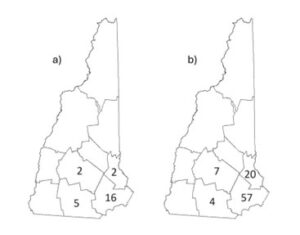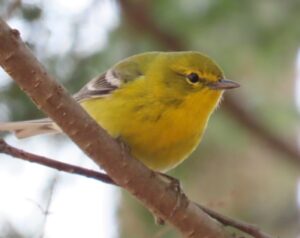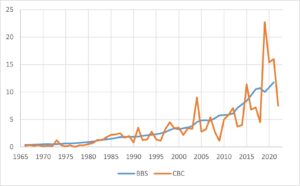(Photos and story by Pam Hunt)

It seems a little odd to feature a warbler in a Bird of the Month for March, but the Pine Warbler (Setophaga pinus) makes sense for a couple of reasons. For starters, it’s usually the first warbler to return to New Hampshire each spring, sometimes as early as late March and slightly ahead of our other two early warblers, the Palm and Yellow-rumped. The other reason is much more timely, since the winter of 2023-24 that just ended was an exceptional one for this species in the state. Figure 1 shows the numbers of individual Pine Warblers reported to eBird this past winter compared to the previous five winters combined. To put these maps into words, there was an average of five warblers each winter prior to this past one, when we had almost a hundred. That’s an exceptional increase if there ever was one!


You can see the increasing trend in winter numbers in Figure 2, which combines Christmas Bird Count data from all six New England states. This notably does not include counts from 2023-24, but you can bet there’ll be a significant uptick! We’ve seen this increase in winter numbers in other migrant species, most recently the White-throated Sparrow (October 2023), but unlike the sparrow Pine Warblers are increasing during the breeding season as well. In the 1980s they only occurred south of the White Mountains, but now also occur in low numbers in Coos County. Reasons for this increase are poorly known but might include adaptation to pine plantations and suburban habitats.
Although Pine Warblers do occur as far north as the Canadian border, observers need to be wary of identifying them by song alone. They are one of our three confusing “trillers,” a group that also includes Chipping Sparrow and Dark-eyed Junco, and the latter in particular is much more common in the north. Early spring is a good time to become more familiar with these overlapping songs, since Pine Warblers and Chipping Sparrows are arriving while juncos are still in southern New Hampshire. Of the three, the Pine Warbler is arguably the most musical, which isn’t saying much for these songs. The best way to learn is through experience, and it always helps to try seeing the singer to reinforce the association between what you hear and what the bird looks like.
State of the Birds at a Glance:
- Habitat: Hardwood/Mixed Forest, Developed Areas
- Migration: Short-distance
- Population trend: Strongly increasing
- Threats: None identified
- Conservation actions: Maintain a bird-friendly yard (keep cats indoors, minimize collisions)
More information on “The State of New Hampshire’s Birds” is available here.
